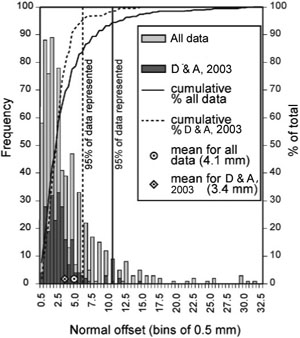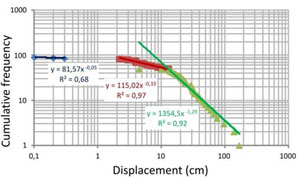| |||||||
|
|
|||||||
|
|
|||||||
| Shear Band Displacement | |||||||
|
It is well known that shear displacement across single shear bands is quite small. Aydin (1978) reported that shear displacement across the bands in the Entrada and Navajo sandstones at the San Rafael Desert and Arches National Park (both in Utah) is on the order of a few millimeters, rarely to a few centimeters. Figure 1 is a plot of shear band displacement data collected from the bands in the Jurassic sandstones of the Colorado Plateau by various workers, which shows that the maximum value is slightly above 3 centimeters with the mean values being 3.4 and 4.1 millimeters (compilation by Davatzes and Aydin, 2003 from different studies). Figure 2 shows displacement frequency data collected from shear bands in the carbonate grainstone cropping out in the island of Favignana, west of Sicily. The data shows that the distribution of displacements across shear bands (both single and zone) is limited in magnitude and is linear in form but the well-developed shear bands with slip surfaces have relatively larger displacements. There is little data for the closure across single compaction bands. Calculated from the maximum thickness and the average measured porosity reduction (about 50%) from Mollema and Antonellini, 1996; Sternlof et al., 2005; Schultz et al., 2008; and Aydin and Ahmadov, 2009, a closure range of about 0.1 to 1.25 cm appears to be reasonable. | |||||||
| Reference: |
|||||||
| Aydin, A., 1978 Aydin, A., Ahmadov, R., 2009 Davatzes, N.C., Aydin, A., 2003 Fossen, H., Hesthammer, J., 1997 Mollema, P., Antonellini, M., 1996 Schultz, R.A., Soliva, R., Fossen, H., Okubo, C.H., Reeves, D.M., 2008 Sternlof, K.R., Rudnicki, J.W., Pollard, D.D., 2005 Tondi, E., Cilona, A., Agosta, F., Aydin, A., Rustichelli, A., Renda, P., Giunta, G., 2012 |
|||||||
|
Readme | About Us | Acknowledgement | How to Cite | Terms of Use | Ⓒ Rock Fracture Knowledgebase |
|||||||

